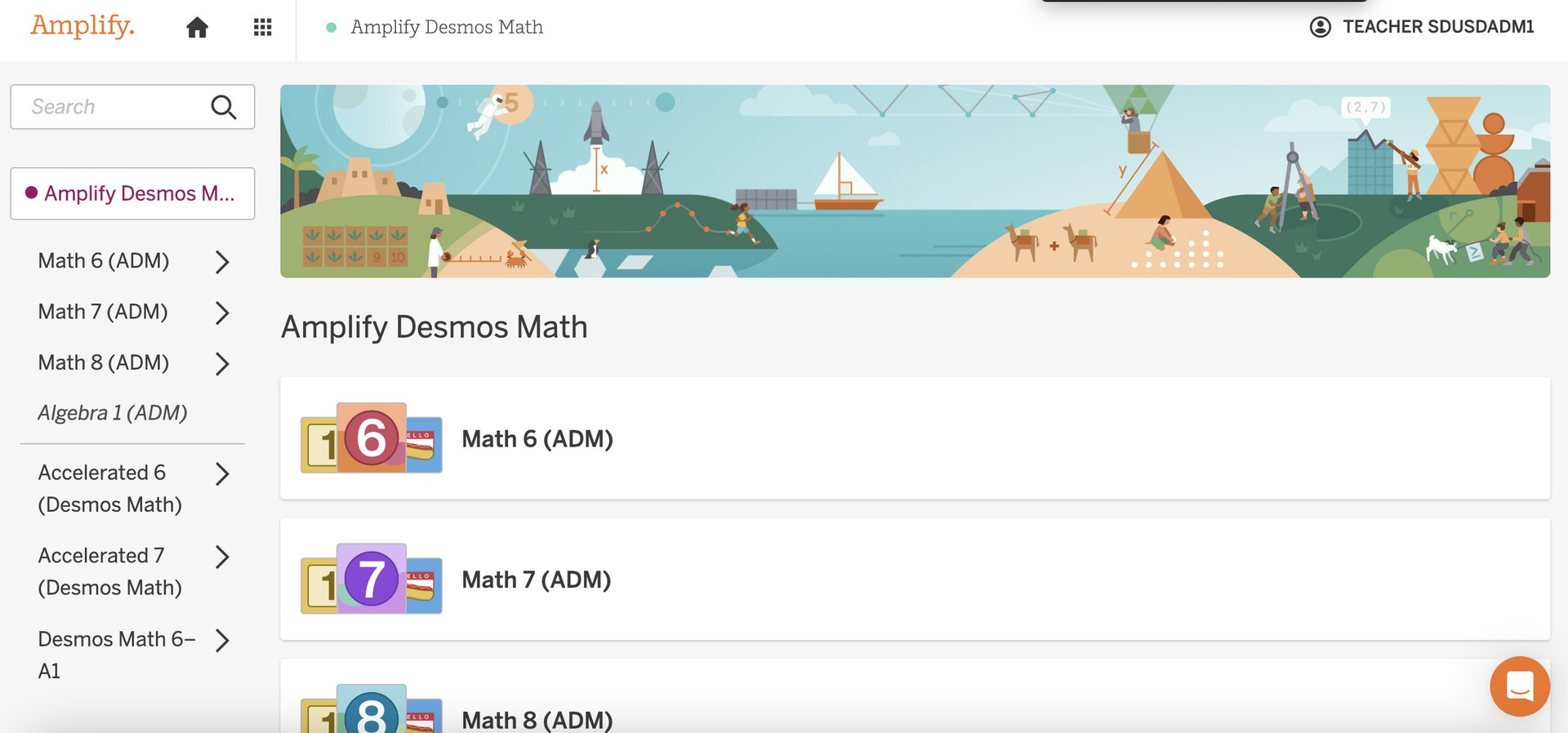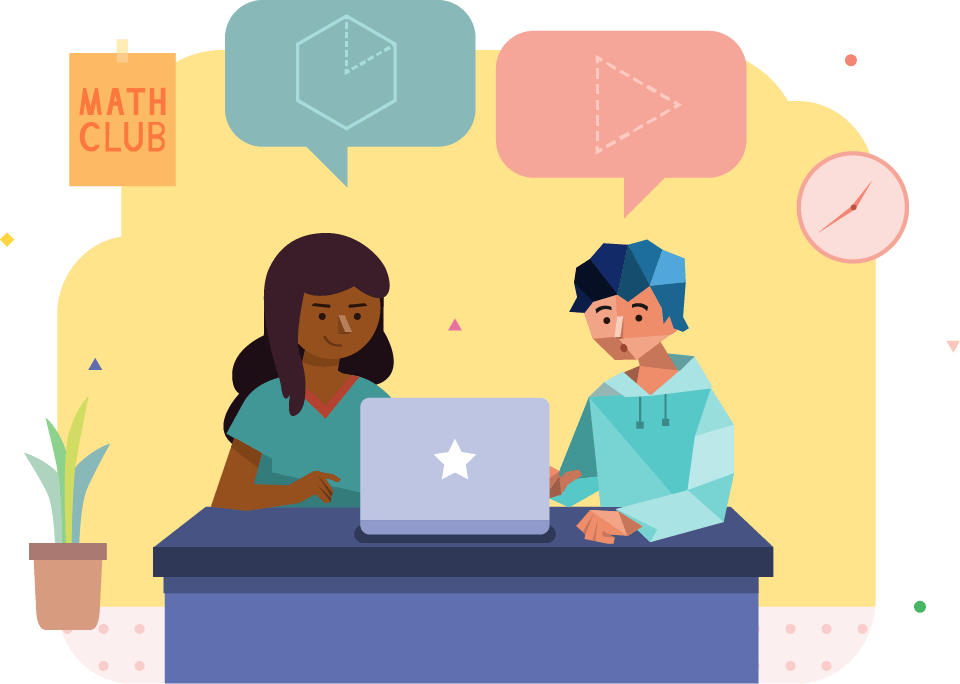San Diego Caregivers — Welcome to Amplify Desmos Math!
Welcome to the Amplify Desmos Math Caregiver Hub for San Diego USD. We’re excited to partner with San Diego USD teachers, principals, and district leaders to provide your student with exceptional opportunities to learn math. We designed this hub to help you in supporting your student along their math journey this year.

- Introducing Amplify Desmos Math
- About student-centered math instruction
- What materials do students use?
- What does a lesson look like?
- How can families support math learning at home?
- Find the math in everyday life
- Review practice problems together
- Remember getting stuck is okay
- Use our Unit Summaries for Families
- Listen to our podcast
- How do families access the program at home?
Introducing Amplify Desmos Math
Amplify Desmos Math is a new core math curriculum built for grades 6, 7, 8. Designed to help students learn math in a way, Amplify Desmos Math uses a student-centered approach to instruction, which has been proven to significantly increase math learning.
In every lesson, Amplify Desmos Math poses engaging and relevant problems to solve, giving students daily opportunities to think critically, work collaboratively, and actively participate in their own learning.

Amplify Desmos Math was built upon the highly rated Illustrative Mathematics curricula: IM K-12 Math™️, which earned an all-green score on EdReports.
About student-centered math instruction
Student-centered instruction may look different from the way students have learned math for decades, and maybe even the way you learned math. Instead of memorizing formulas and tricks, student-centered learning focuses on giving student opportunities to figure out how math works. Plus, research shows that students and teachers alike prefer this method, and teachers report that student-centered instruction has helped their students learn more math.

This way of learning helps students:
- Understand how math concepts work.
- Remember what they learn in class and apply their knowledge to new situations.
- Perform better on standardized tests and have more growth in their grades than their peers who learn through other methods.
- Learn to communicate in writing and verbally, understand and challenge the opinions of others, and build confidence in solving new problems.
- Develop key skills for success in college and the workplace, like using technology, completing projects independently and with others, and persevering through difficult problems.
What materials do students use?
Amplify Desmos Math supports blended learning with supportive print materials and a unique digital experience. In addition to a consumable Student Edition, students are invited to use our interactive online platform to solve open-ended tasks and challenging problems.

Here are some key highlights of the digital platform:
- Digital activities that allow students to explore and make sense of math
- Digital calculator and virtual manipulatives that support students of all levels
- Immediate feedback that guides students in understanding challenging concepts
- Ability to access instructional materials in English or Spanish
With access to their own special online dashboard, teachers can monitor students’ work in real time, making sure they get the exact support that they need at every part of the lesson.

What does a lesson look like?
Students in an Amplify Desmos Math classroom can be seen (and heard!) — asking questions, debating answers, justifying their thinking, grappling with problems, and working together and independently.

In class, your student will spend their time working on challenging problems while the teacher acts as a guide, highlighting different strategies for solving problems and helping students to understand the reasoning behind the math they do in class. Your student will be pushed to think more deeply about the math in their class as the teacher and other students question them on why their ideas make sense. Research has proven that this method helps students become better problem solvers, critical thinkers, and have a stronger conceptual understanding of what they are learning.
Here’s what a typical Amplify Desmos Math lesson includes:
- Warm-up: A short, attention-getting problem to get students interested in the lesson
- Activities: 1-3 mini-activities that challenge students’ problem-solving skills
- Synthesis: Discussion to review and bring together the important concepts from the lesson
- Exit Ticket and Reflection: Questions for students to show what they know from the lesson
- Practice: Additional problems your student’s teacher may assign for classwork or homework
How can families support math learning at home?
Find the math in everyday life
Relate math to daily activities at home, whether it be baking, grocery shopping, or planning for a road trip. Your student can help you figure out the price of an item after a coupon, cut a recipe in half, or figure out how much gas you’ll need to make it to your destination. Encourage your student to point out ways that your family uses math in your daily tasks.
Review practice problems together
Your student’s teacher may assign practice problems at the end of each lesson for classwork or homework. Ask your student to walk you through how they solved each problem, or talk about any parts that were challenging for them.
Remember getting stuck is okay
Emphasize that getting stuck is part of the process and a necessary part of learning. Many students (and adults!) fear making mistakes, however, research shows that making mistakes helps your brain grow more. When your student gets stuck on a problem, encourage them to try different strategies, even if they are not sure if they are right.
Use our Unit Summaries for Families
We’ve created a Family Resource for every unit of the program that provides a summary of key concepts plus examples for how to work through problems.
Within each of the grade-level links below, you’ll find a Family Resource document for each unit, in both English and Spanish.
-
Grade 6
-
Grade 7
-
Grade 8
-
Accelerated 6
-
Accelerated 7
Listen to our podcast
Our Math Teacher Lounge is a biweekly podcast created specifically for K–12 math teachers. In each episode, co-hosts Bethany Lockhart Johnson (@lockhartedu) and Dan Meyer (@ddmeyer) chat with expert guests, taking a deep dive into the math and educational topics.
From time-to-time, the topic of an episode is perfect for families. For example, the episode below features Dr. Marjorie Schaeffer. She discusses what causes math anxiety, math hacks, and how the right math technology can make an incredible impact in children and family members who struggle with math anxiety.
Listen today and don’t forget to grab your MTL study guide to track your learning and make the most of this episode!
How do families access the program at home?
Your student will have access to all learning, practice, and assessment materials through the Amplify platform. Students can access the digital curriculum in school and at home by following these simple instructions.
- Click the Amplify Desmos Math button.
- Select Log in with Amplify.
- Enter this username and password provided by your student’s teacher.
- Select the desired grade level.